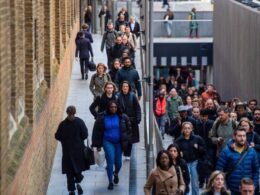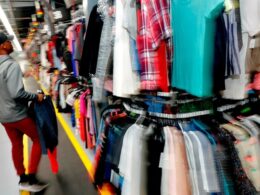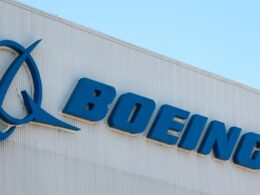As the Village People’s anthem YMCA blared across the ballroom, Crown Prince Mohammed bin Salman strode to the stage where Donald Trump had just delivered a speech replete with boasts about his presidency and superlatives describing the “incredible” Saudi royal.
With huge Saudi and American flags behind him, a beaming Prince Mohammed clasped the US president’s hand, while Trump gripped the heir apparent’s shoulder. “I like him a lot,” Trump said. “I like him too much.”
It was an embrace that epitomised the tenor of Trump’s trip to the oil-rich Gulf, with stops in Saudi Arabia and even wealthier Qatar and the United Arab Emirates: a four-day jamboree of opulent ceremonies, unabashed flattery and, above all, a glut of petrodollar-fuelled deals the transactional president so cherishes.
“Are we doing a good job so far for America?” Trump said as he walked through the conference centre. “They’re only putting in a trillion dollars.”
As is often the case with Trump, there appeared to be plenty of hyperbole, making it hard to separate fact from fiction. The White House said $600bn in deals was agreed, including a $142bn arms deal as well as investments in artificial intelligence and energy.
At just under $300bn, the actual listed agreements came to half that figure, though Prince Mohammed said the plan in the coming months was to increase it to $1tn.
The US president had made no secret that economic deals would be the focus of the visit after choosing the autocratic Gulf — rather than American’s western allies — for the first foreign tour of his second term, knowing there would be no talk of tariffs or trade wars, nor public challenges to his world view.
Combined, the three Gulf states manage more than $3tn in sovereign wealth funds and are traditional US partners that have historically looked to Washington for security and are big buyers of American weaponry.
Each has ambitious leaders who want to project their states on the global stage as they pursue lofty domestic development goals that include pouring tens of billions of dollars into American technology, particularly AI, as they seek to develop new industries and reduce their dependence on fossil fuels.
Frustrated with swings in US policies, they have long wanted greater commitment from Washington on trade and security, and have been actively courting Trump since his first term, embracing his transactional style even if they are wary of his unpredictability.
But the trip also came against a backdrop of apparent Trump family self-dealing that raised hackles at home. Ahead of the trip this month the Trump Organization, run by the president’s son Eric, launched a hotel in Dubai and struck a real estate deal involving a Qatari state-owned company.

The US/Qatar $1.2tn ‘economic exchange’ in context
213
years of 2024 US/Qatar trade
For weeks, teams from the US and the Gulf states thrashed out details of what deals could be inked, ensuring the tone of the visit was set by the time Air Force One — escorted by six Saudi fighter jets — touched down in Riyadh on Tuesday morning.
Prince Mohammed broke Saudi protocol to greet Trump at the airport and walk him down a lavender carpet surrounded by a guard of honour. It was a stark contrast to the frostier welcome that greeted President Joe Biden, who exchanged an awkward fist bump with Prince Mohammed on his visit in 2022.
On Wednesday, Trump received another regal welcome in Doha from Sheikh Tamim bin Hamad al-Thani, the emir of Qatar — more fighter jet escorts and more guards of honour.
Trump revelled in the royal pomp and conspicuous wealth, marvelling at the “perfecto” marble of a palace and camels ridden by members of the royal guard.
“I appreciate those camels,” he said. “I haven’t seen camels like that in a long time.”
Qatar, one of the world’s wealthiest nations in per capita terms, also delivered on the deal front. The White House announced agreements worth more than $243bn, including Qatar acquiring 210 Boeing jets, which Trump bragged was the biggest order of jets in the American company’s history.
There was also a seemingly aspirational line about agreement with Qatar to generate an “economic exchange” worth at least $1.2tn, as the White House kept totting up the numbers to back Trump’s “America first” investment policy. But once again, it gave no details or timelines on how the figure — equivalent to more than 500 per cent of the Gulf country’s annual GDP — would be reached.
A Qatari official said it included all expected trade between the two countries, such as energy sales, arms deals and other investments over the next 10 years. That includes an intent by the Qatar Investment Authority, the $450bn sovereign wealth fund, to invest $500bn in the US over the next decade.
There was no mention of the Qatari “gift” to Trump that had stirred controversy in the lead up the trip: Doha’s offer of providing the US with a luxurious jumbo jet to temporarily replace Air Force One.
But Trump was in good spirits as he compared Sheikh Tamim to Saudi’s Prince Mohammed as both “tall, handsome guys that happen to be very smart”.
The most significant diplomatic breakthrough came courtesy of a different “young, attractive” leader: Ahmed al-Sharaa, the Syrian president and former Islamist rebel leader whom Trump met after a surprise announcement that the US would lift sanctions on the war-shattered country.
There was little public attention to the 19-month war in Gaza, however. Sheikh Tamim did make a plea to Trump to help end the war during a banquet at one of his palaces, saying that it was “the key to wider stability in the region”.
“Time is short. The people across the region are watching not for words, but for outcomes,” he said. “They are waiting to see if this moment brings that peace.”
But the emir focused on Trump’s favourite topic, investments in the US, with the president hailing the “perfect evening”. He and other guests had, after all, been serenaded by American country singer Lee Greenwood — a Trump favourite — who sang “God Bless the USA”.

UAE’s $1.4tn investment commitment in context
41
years of 2024 US/UAE trade
On Thursday, it was the UAE’s turn to roll out the proverbial red carpet as Trump landed in Abu Dhabi. There he was feted by President Sheikh Mohamed bin Zayed al-Nahyan in the knowledge that the UAE had already committed in March to investing $1.4tn in the US over the next decade.
“We’re going to be your friend and we’re going to be your partner,” Trump told the Emirati leader. “We’re going to treat you, as you should be: magnificently.”
Hours later, the White House announced deals with the UAE worth $200bn, including for Boeing jets, energy projects and technology.
Emile Hokayem, at the International Institute for Strategic Studies, said the Gulf states and Trump were similar in many ways: “they are good at superlatives, overstating and inflating and promising big”.
“They achieve results nonetheless and they surprise. A lot of it is for show, but the point is both sides got what they wanted: the visibility, exchange of goodwill, mutual validation,” Hokayem said. “There’s hyperbole everywhere, but even if 50 per cent materialises, it’s still a big win for them.”
Source link









